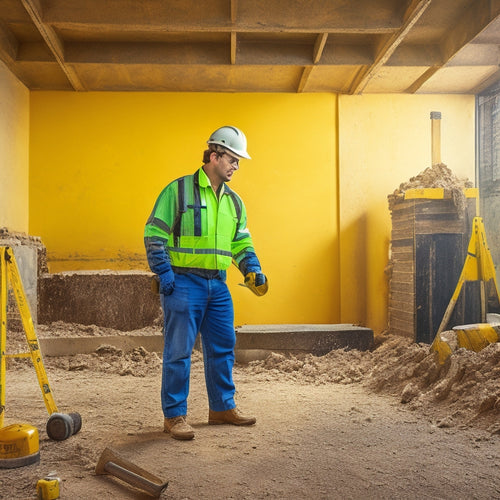
Streamlining Your Exterior Renovation Timeline
Share
To streamline your exterior renovation timeline, start by identifying your project goals and objectives, and prioritize your must-haves from nice-to-haves. Assess your current exterior condition, create a realistic budget, and choose reliable contractors and suppliers. Develop a detailed task schedule, plan for weather contingencies, and secure necessary permits and approvals. Establish clear communication protocols to guarantee all parties are on the same page. By following these steps, you'll be well on your way to altering your outdoor space into a functional oasis that enhances your home's curb appeal and resale value. Now, take the next step towards turning your vision into a reality.
Key Takeaways
- Prioritize goals and objectives to maintain focus and avoid scope creep, ensuring desired outcomes like curb appeal and functional outdoor space.
- Conduct a thorough exterior condition assessment to identify areas of concern, inform renovation priorities, and create a realistic project timeline.
- Develop a comprehensive budget projection that accounts for materials, labor, permits, and contingencies to avoid costly surprises.
- Establish effective communication protocols with contractors and suppliers to ensure accountability, transparency, and timely issue resolution.
- Create a flexible task schedule with buffers for contingencies and weather-related delays to minimize project disruptions and ensure timely completion.
Identify Project Goals and Objectives
Before diving into your exterior renovation project, take a step back and identify what you want to achieve. What do you want to accomplish with this renovation? Are you looking to enhance your home's curb appeal, increase its resale value, or simply create a more functional outdoor space? Clarify your goals to guarantee everyone involved in the project is on the same page.
Once you've defined your objectives, prioritize them. Determine which goals are must-haves and which are nice-to-haves. This will help you allocate resources effectively and make decisions when faced with trade-offs. Goal alignment and project prioritization are vital in maintaining focus and avoiding costly scope creep.
Take the time to ask yourself questions like: What're my non-negotiables? What can I compromise on? What'll I achieve with this renovation, and how will it impact my daily life?
Assess Current Exterior Condition
You'll need to inspect your exterior walls to identify any cracks, damage, or water infiltration.
Next, take a close look at your siding to spot any damaged or rotten sections that need replacing.
Exterior Walls Inspection
As you step outside to assess your home's exterior condition, one thing becomes clear: the exterior walls are the first line of defense against the elements. They protect your home from harsh weather, moisture, and pests.
During your exterior walls inspection, take note of the current exterior materials selection, including the type of siding, trim, and accents. Are they durable and low-maintenance, or do they require frequent repairs?
Also, consider the insulation options in your exterior walls. Are they energy-efficient, or do they let heat escape?
Check for any gaps, cracks, or signs of wear around windows, doors, and corners. These areas are prone to air leaks and water intrusion, which can lead to costly repairs down the line.
Damaged Siding Identification
Frequently, damaged siding is hiding in plain sight, and it's essential to identify these issues to prioritize your exterior renovation tasks.
As you assess your exterior condition, take a closer look at your siding materials, including vinyl, wood, and metal. Check for cracks, warping, or rotting, which can lead to water damage, pest infestations, and heat loss.
Identify areas with missing or loose siding, as well as those with signs of wear around windows, doors, and corners. Take note of any gaps or openings that could let air escape or water seep in.
Consider the age and condition of your siding, as older materials may require more extensive repairs or even replacement.
When it comes to repair techniques, you may need to replace individual boards or panels, or apply specialized coatings to protect your siding from further damage.
In some cases, a full siding replacement may be necessary. By identifying damaged siding now, you can avoid more costly and time-consuming repairs down the line.
Outdoor Feature Assessment
Most exterior renovations involve multiple components, and it's crucial to assess each outdoor feature to determine what needs attention. This assessment helps you prioritize tasks, allocate resources, and guarantee that your renovation stays on track.
Take a walk around your property and evaluate each outdoor feature. Consider the following:
| Outdoor Feature | Condition |
|---|---|
| Garden Design | Overgrown, outdated, or functional? |
| Outdoor Lighting | Dim, broken, or sufficient? |
| Patios and Walkways | Cracked, uneven, or safe? |
| Gutters and Downspouts | Clogged, damaged, or functioning properly? |
| Fencing | Rusted, broken, or secure? |
Be honest about the condition of each feature. If you're unsure about any aspect, consider consulting a professional. This assessment will help you create a thorough renovation plan that addresses all your outdoor needs. By evaluating each feature, you'll avoid costly surprises and guarantee that your exterior renovation is completed efficiently and effectively.
Create Realistic Budget Projections
Your wallet is about to take a significant hit, so it's crucial to create realistic budget projections for your exterior renovation.
A well-planned budget will help you allocate funds efficiently, prioritize expenses, and avoid costly surprises.
To create a realistic budget, you'll need to estimate the cost of each component of your renovation. This includes materials, labor, and permits.
Here are three key considerations for accurate cost estimation:
-
Material costs: Research the prices of materials you'll need, including lumber, roofing, siding, and landscaping features.
-
Labor costs: Determine the cost of hiring professionals, such as contractors, electricians, and plumbers.
-
Permit fees: Factor in the cost of obtaining necessary permits and inspections.
Choose Reliable Contractors and Suppliers
With your budget in hand, it's time to assemble a team of reliable contractors and suppliers to bring your exterior renovation vision to life. This vital step guarantees that your project stays on track and within budget.
You'll want to focus on contractor vetting, researching potential candidates thoroughly to find the best fit for your project. Check online reviews, ask for referrals, and verify licenses and certifications.
It's also important to assess supplier reliability, as a single delayed delivery can throw off your entire timeline. Research suppliers' track records, ask about their shipping and handling procedures, and read reviews from other customers.
When evaluating contractors and suppliers, don't be afraid to ask tough questions. What's their experience with projects similar to yours? Do they have a clear plan for managing timelines and budgets? What kind of warranties or guarantees do they offer?
Develop Detailed Task Schedules
Now that you've assembled a reliable team of contractors and suppliers, it's time to create a roadmap for your exterior renovation project. A detailed task schedule will help you stay on track, manage your team, and make the most of your budget.
To create a solid schedule, start by identifying the most critical tasks that need to be completed. Then, break down each task into smaller, manageable chunks, and assign realistic deadlines to each one. This will help you avoid last-minute rushes and guarantee that every aspect of your renovation is given the attention it deserves.
Here are three essential strategies to keep in mind when developing your task schedule:
-
Prioritize tasks based on importance and urgency: Focus on the most critical tasks first, and allocate your resources accordingly.
-
Use timeline adjustment techniques to accommodate unexpected delays: Be prepared to adjust your schedule if unexpected setbacks occur, and have a plan B in place to minimize downtime.
-
Leave buffers for contingencies and flexibility: Build in some extra time and resources to account for unexpected expenses or changes to your original plan.
Plan for Weather Contingencies
You'll need to plan for weather contingencies to avoid costly delays and guarantee your exterior renovation stays on track.
Consider weather delay scenarios, such as heavy rain or extreme temperatures, and develop rainy day protocols to minimize their impact.
Weather Delay Scenarios
Weather Delay Scenarios
Typically, exterior renovation projects involve a significant amount of outdoor work, making them susceptible to weather delays. You need to be prepared for unexpected weather conditions that can impact your project timeline.
When planning for weather contingencies, consider the following scenarios:
- Winter weather: Snow impact and freezing temperatures can halt outdoor work, while wind damage can compromise the structural integrity of your home.
Make certain you have a plan in place for storm preparation and seasonal trends.
- Temperature fluctuations: Extreme heat or cold can affect the quality of materials and the workability of certain products.
Be prepared to adjust your schedule accordingly.
- Humidity effects: High humidity can delay drying times for paints, coatings, and adhesives.
Factor in these delays to avoid costly rework.
Rainy Day Protocols
When raindrops start falling, your exterior renovation project can quickly come to a standstill. But with a solid rainy day protocol in place, you can minimize delays and keep your project on track.
First, make certain your contractor has a plan for securing the worksite when rain hits. This includes covering materials, tools, and equipment to prevent damage. You should also guarantee that the crew has the necessary rain gear to keep them safe and comfortable while working in wet conditions.
Next, establish a communication plan with your contractor to stay informed about weather-related delays. This will help you adjust your schedule and make informed decisions about the project.
Remember, worksite safety is paramount on rainy days. If the weather is severe, it may be necessary to halt work altogether to prevent accidents.
Seasonal Flexibility Needed
As exterior renovation projects often span several months, it's essential to build seasonal flexibility into your timeline to accommodate unpredictable weather conditions.
You can't control the weather, but you can plan for its impacts. Seasonal considerations will help you adapt to changing weather patterns, guaranteeing your project stays on track.
To account for weather contingencies, consider the following:
-
Winter slowdowns: Prepare for potential delays due to frozen ground, cold temperatures, or snow. Identify tasks that can be completed indoors or during milder winter days.
-
Spring showers: Be ready for rain delays by having a backup plan, such as indoor work or using waterproof materials. Take advantage of dry spells to complete outdoor tasks.
-
Summer heatwaves: Plan for heat-related work restrictions, such as scheduling tasks for early morning or late evening. Make sure your team stays hydrated and protected from the sun.
Secure Necessary Permits and Approvals
One essential step in your exterior renovation process is obtaining the necessary permits and approvals. This guarantees that your project complies with local building codes and regulations, avoiding costly delays or fines.
You'll need to submit a permit application, which will trigger an approval timeline.
| Permit Type | Required For |
| Building Permit | Structural changes, electrical, plumbing, or HVAC work |
| Zoning Permit | Changes to property use, setbacks, or land use |
| Environmental Permit | Projects affecting natural habitats or waterways |
| Electrical Permit | Electrical installations or upgrades |
Remember to factor in the approval timeline when planning your project. This can vary depending on the complexity of your application and the workload of your local authorities.
Be prepared to provide detailed plans and specifications to support your permit application. By obtaining the necessary permits and approvals upfront, you'll avoid costly rework and guarantee a smoother renovation process.
Establish Communication Protocols
Now that you've secured the necessary permits and approvals, it's time to establish clear communication protocols with your project team, including contractors, suppliers, and local authorities.
This will guarantee that everyone is on the same page and that your exterior renovation project stays on track.
To do this, you'll need to identify the most effective communication tools for your team. This might include project management software, regular meetings, or a dedicated messaging app.
Whatever tools you choose, make certain they facilitate open and transparent communication.
Here are three key elements to include in your communication protocols:
-
Clear expectations: Clearly define roles, responsibilities, and timelines to avoid confusion and miscommunication.
-
Feedback loops: Establish regular check-ins and progress updates to guarantee that everyone is aware of changes or issues that may arise.
-
Issue escalation procedures: Identify a clear process for addressing and resolving conflicts or issues that may arise during the project.
Frequently Asked Questions
Can I Live in the House During the Renovation Process?
You can live in the house during the renovation, but it's essential to plan your living arrangements carefully, considering renovation tips like setting up a temporary kitchen and bathroom, and preparing for noise and dust disruptions.
How Do I Handle Unexpected Issues or Surprises?
Did you know 80% of renovations uncover hidden issues? You'll likely face surprises too! Stay calm, and be prepared to make budget adjustments. Develop clear communication strategies with your contractor to tackle unexpected problems, ensuring a smoother, stress-free process that respects your freedom and timeline.
Are There Any Specific Renovation Permits I Need to Obtain?
You'll need to traverse renovation regulations, obtaining necessary permits before starting the project. Research permit types, like building, electrical, and plumbing permits, to guarantee you're compliant and avoid costly delays.
Can I Make Changes to the Plan After It's Already Started?
You're not stuck in cement, and changes are possible, but be prepared for a ripple effect on your timeline and budget. With some timeline flexibility, you can make plan adjustments, but prioritize what's essential to avoid costly and time-consuming revisions.
What Happens if the Contractor Doesn't Meet the Deadline?
If your contractor misses the deadline, you're entitled to contractor penalties or timeline extensions, so don't hesitate to negotiate; you've got the upper hand to guarantee the project gets back on track, and you get the results you desire.
Conclusion
You've finally made it to the end of your exterior renovation timeline, and guess what? The real fun begins now - dealing with the chaos and uncertainty that comes with actual construction. But don't worry, with a solid plan in place, you'll be well-equipped to handle the unexpected twists and turns. Remember, a successful renovation is all about adapting to change, and laughing at the irony of your once-tidy backyard now resembling a war zone.
Related Posts
-

Why Inspect Stucco Repair Equipment Before Renovation
When starting a stucco repair renovation, you need to inspect your equipment to prevent accidents, save time and mone...
-

5 Vital Safety Tips for DIY Renovation Success
When tackling a DIY renovation, you'll need to prioritize safety above all else. Start by protecting yourself from fl...
-

Stucco Patching Material Checklist for Home Renovation
You'll need a range of essential tools, including a putty knife, wire brush, hawk or flat trowel, level, and straight...


